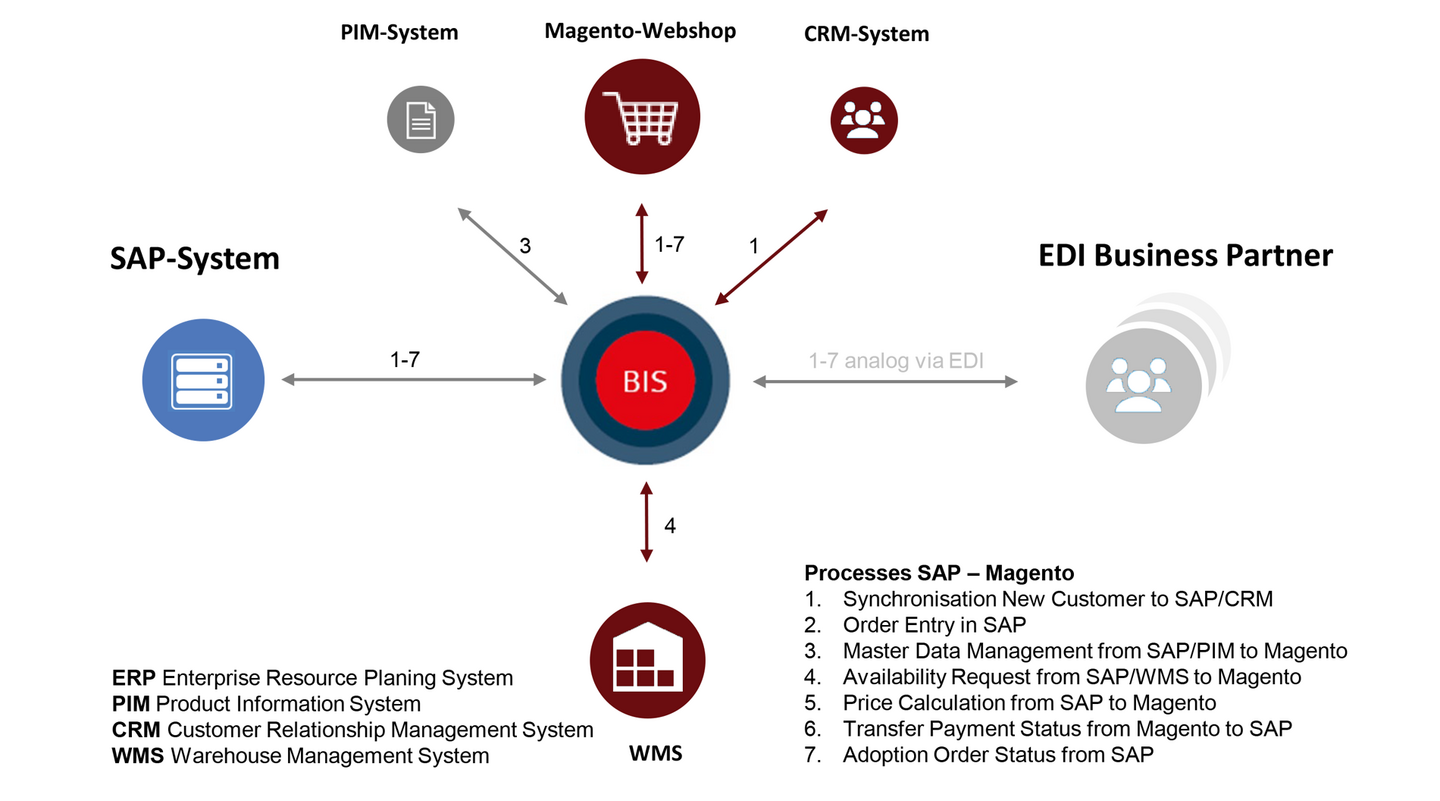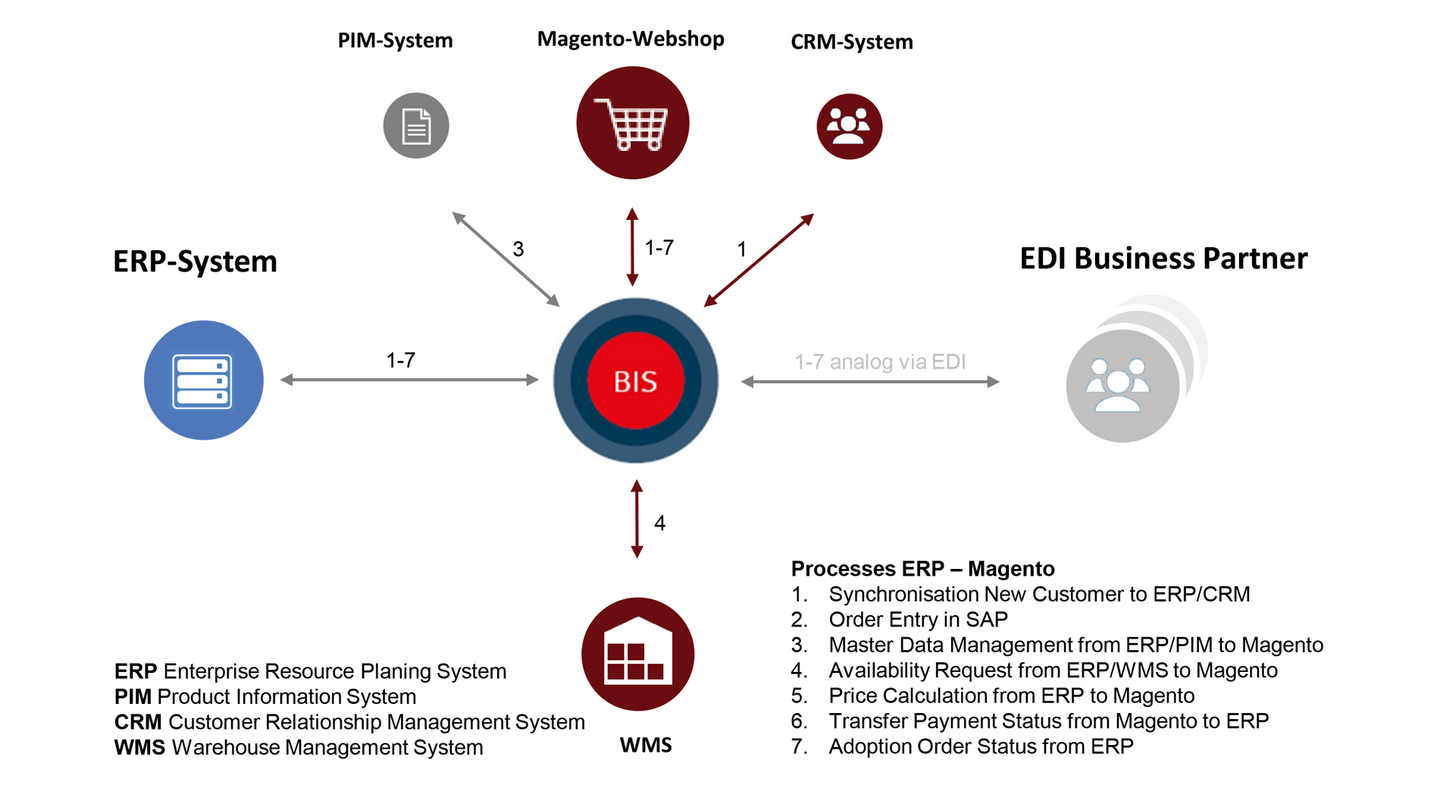
Magento Integration from A to Z
Holistic integration of the e-commerce platform independent from API, operating model, CRM or ERP system
Many companies face the challenge of seamless Magento integration. Why? Magento has long been synonymous with e-commerce software. Even Gartner distinguished Magento. Magento enables you to build seamless digital shopping experiences and connect different touchpoints. There are comprehensive functionalities and numerous customization options for analysis, marketing, content creation and commerce, all in the spirit of holistic customer experience management.
However, it is the many possibilities of Magento integration that often push IT departments to their limits. The first task is the integration into the ERP system. With each additional touchpoint, new interfaces are added. The integration of CRM, PIM and warehouse management systems is mandatory. A 360° customer viewing BI database is more advanced. In this context, many other systems need to be synchronized with the Magento shop as well. It doesn't matter whether it was planned long ago or whether it was launched as a result of a campaign. This leads to the following holistic view of Magento integration.
Magento Integration
Magento SAP Integration
Take the very common case of Magento integration with SAP. There are countless combinations for this use case alone, e.g. on the Magento shop side:
- Magento 1, no longer supported in the future, but still frequently in use
- Magento 2, on-premises as well as available in the cloud
- as free Magento Community Edition or
- Proprietary Magento Enterprise Edition.
Moreover, on the ERP system side:
- SAP R/3
- mySAP
- SAP ECC
- the cloud solution SAP Business ByDesign or
- SAP S/4HANA for the current digital age

Magento ERP Integration
Besides SAP, there are a number of other ERP software providers such as Sage, Oracle, Infor, Microsoft with MS Dynamics 365 - to name just a few. Many companies have several ERP solutions in use: in different countries, for different product groups or for historical reasons such as takeovers, mergers, etc.
In a multilingual web shop, all ERPs are needed equally. They provide important information such as product names, descriptions, availability. This is what makes Magento integration so complex. A lot depends on the IT architecture, a possible PIM system or other ways of translation. Integrating Magento into the ERP can therefore be quite complex or can only be simplified over time with the appropriate systems.
The BIS EAI/A2A capabilities significantly reduce the challenges of Magento integration. They manage, translate, update or even set end-of-life rules, prioritizations and staging tables for entire web shop categories.

BIS EAI/A2A capabilities to solve for further challenges of Magento Integration in PIM, CRM or Warehouse Management Systems
As mentioned earlier, the IT framework of the Magento web shop includes vital components such as PIM, CRM, and warehouse management systems. These are essential for the efficient functioning of medium-sized businesses. Their applications vary, driven by decisions from different business units. Unfortunately, initial planning often overlooks the need for seamless integration and coordination between these systems. Despite its critical role in Magento integration, the IT aspect is frequently excluded from the selection process.
This dynamic often leads to situations where disparate systems are combined without the need for adapters. Better interdepartmental communication during new launches could have altered outcomes. It's not uncommon for previously effective interfaces to be swapped out during Magento integration.
Currently, systems with API-based interfaces are particularly popular. Although these can be easily connected, the data relevant for the Magento shop is still often located in legacy systems. They are often required to build services or campaigns from within Magento.
Campaigns are always tailored to the customer (location, time, history, etc.) This explains the great complexity underlying digital, automated marketing. CRM (and especially Salesforce CRM) probably plays the most important role here, alongside
BIS EAI/A2A capabilities provide comprehensive API integration for Magento
BIS enables all export and import processes into the Magento system, the SAP system and all other systems involved. It is irrelevant whether the Magento integration is done via the Magento APIs of the Commerce Cloud, synchronous REST or SOAP web services, local files, FTP servers or IDocs.
BIS facilitates swift and effortless Magento integration via configuration, eliminating the need for extensive programming endeavors. This, in turn, ensures the dependable execution and event-triggered monitoring of subsequent process steps. With the aid of SEEBURGER middleware, data exchange and comparison can be adapted dynamically. Requests are meticulously sequenced, ensuring seamless consecutive execution according to requirements, yielding accurate responses.
This approach enables the presentation of appropriate product ranges, accurate delivery commitments, and swift order fulfillment. Through comprehensive Magento integration, an ideal shopping experience is crafted, prioritizing the satisfaction of the Magento customer.








